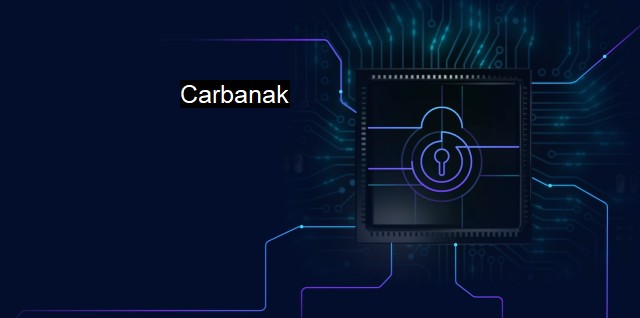What is Carbanak?
The Menace of Carbanak: A Sophisticated Banking Trojan Targeting Financial Institutions Worldwide
Carbanak is a sophisticated and unique form of malware that emerged around 2013 and dramatically reshaped the landscape of cybersecurity threats. Named after the Carba beverage, a favorite off-work treat among the cybersecurity community, Carbanak represents a major shift in the strategies used by criminals to target financial systems.Carbanak is an anomaly among malware due to its premise. Unlike most cyber threats, which generally aim for a widespread dispersal targeting many end users or consumer systems, Carbanak specifically targeted banks and other financial institutions. Therefore, the impact of its activities was decidedly high-ticket crime, focusing on transfer systems and account balances, resulting in significant financial losses.
Carbanak was unique in its approach and operation. Unlike other malware that relies on targeting individual users within an organization to take control of their machines, Carbanak malware foreshadowed a shift towards Advanced Persistent Threats (APTs). Here, the focus was not on breaching as many systems as possible but instead on persisting undetected in a single system or limited network. Thus, we saw the malware utilize stealth tactics, making efforts to go unnoticed for as long as possible, enabling it to inflict greater damage.
Besides, Carbanak's attack vector was distinctive, leaning heavily on spear-phishing emails, a refined and targeted approach that was unseen among malware at the time. These emails contained malicious attachments that, when opened, exploited system vulnerabilities to take over the machine. Once they established a foothold, operators of the malware had complete access to the infected computer and could use it to move laterally within the network - reaching banks' core financial systems. Critically, these systems controlled the money transfer mechanisms and account balances, which the attackers manipulated to their advantage, making off with substantial sums.
The capabilities of Carbanak are nothing short of remarkable; it was capable of video recording the screens of compromised systems. An unusual feature for malware, but exceptionally useful in the targeted banking environment, it allowed attackers to learn from and mimic the behavior of bank employees, helping it blend in and raising no red-flags. It also generated fake transactions or artificially inflated balances in accounts, which were then drained without immediate detection.
Making it particularly insidious, the Carbanak attacks were very difficult to detect by antivirus systems because of its advanced evasion techniques and the use of legitimate administrative tools, making detection by traditional signature-based antivirus solutions nearly impossible. This highlights the challenges faced by cybersecurity professionals in dealing with such sophisticated threats and raises serious questions about designing sustainable and effective security systems.
In response to the crime spree initiated by Carbanak, the cybersecurity community strengthened its efforts, resulting in heightened global awareness about the potential impacts of cybercrime on financial institutions. It challenged banking institutions to upgrade their antivirus and cybersecurity systems and imbued in them an understanding that a proactive approach may be the best defense against cyber threats like Carbanak.
The arrest of the Carbanak gang in Spain in 2018 marked a turning point in the fight against bank-targeting cybercrime. the malware continues to evolve, posing a constant threat to the cybersecurity landscape.
Carbanak represented a new era of cybersecurity threats, targeting financial institutions directly and leading to considerable financial losses. The methods and techniques it implemented marked a continuation of the dynamic manner in which cyber threats can evolve, demonstrating that countering these threats requires continuous innovation and diligence, both in technology and in practice. These attacks were a clear reminder that in taking cybersecurity measures, institutions must anticipate the unpredictable nature of malware threats and maintain a defense-in-depth strategy. In short, the story of Carbanak reminds us of the ever-present, sophisticated, and evolving threats in an interconnected digital world and the urgency of maintaining robust cybersecurity systems to protect against such threats.

Carbanak FAQs
What is Carbanak?
Carbanak is a type of malware that is used by cybercriminals to steal financial information and perform fraudulent transactions. It has been primarily used against banks and financial institutions.How does Carbanak infect computers?
Carbanak can infect computers through various methods, including email attachments, drive-by downloads, and phishing campaigns. Once it infects a computer, it can spread quickly through a network and steal sensitive information.Can antivirus software protect against Carbanak?
Most antivirus software can detect and remove Carbanak, but it can be difficult to completely eliminate the malware. Once it is on a network, it can be challenging to fully eradicate without the help of specialized security tools and expertise.What can individuals and organizations do to protect themselves from Carbanak?
To protect against Carbanak, individuals and organizations should use strong and unique passwords, keep their software up to date, and use antivirus and anti-malware software. They should also be cautious of suspicious emails, links, and downloads, and should regularly back up their data in case of a successful attack.Related Topics
Cybercrime Advanced persistent threat (APT) Malware analysis Endpoint security Banking Trojans
| | A | | | B | | | C | | | D | | | E | | | F | | | G | | | H | | | I | | | J | | | K | | | L | | | M | |
| | N | | | O | | | P | | | Q | | | R | | | S | | | T | | | U | | | V | | | W | | | X | | | Y | | | Z | |
| | 1 | | | 2 | | | 3 | | | 4 | | | 7 | | | 8 | | |||||||